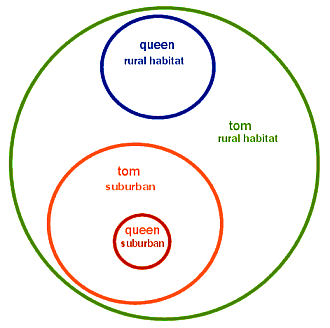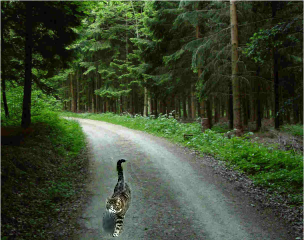The territory of outdoor cats

Cats are solitary animals which normally come together only during the mating season. However, feral cats do sometimes congregate and even form colonies, and often interact with domestic cats. But even in colonies, it is important for each cat to have her own defined area. This area can be subdivided into two distinctive parts: home range and territory. The home range is the area that the cat lives in, and the territory is the area which she defends. The territory is normally smaller than the home range. House cats which are allowed outside will establish their home ranges and territories, although the home range for female house cats is only about 0.05 acre which is approximately 200 m2 (her own garden and adjoining gardens). Interestingly house cats never create colonies with neighboring cats, if they meet it is more to assert their territorial rights.
Home range size varies with the habitat and the availability of the food but there are some defining features.
- Male cats have a home range about 10 times larger then that of a female cat.
- Female cat's ranges clump together, normally around a building or other place of shelter and often overlap.
- A male may include the ranges of a number of queens in 'his' range. The male normally moves on the outer parts of his home range.
- The greater the size of available food the smaller the home ranges.
A number of studies, almost all on feral cats, have been carried out to determine their home range in different habitats. For example 100 cats - 68 females and 32 males - were observed for three years in the Portsmouth Dockyard in Her Majesty's Naval Base, Hampshire, England. The cats in the Dockyard can be described as feral, since they are not domiciled with humans and very few are tame enough to be handled. Nevertheless, they are also not completely independent, since dockyard workers often feed them. The dockyard was chosen for the study because it is almost completely enclosed by the building from one side and the docks and basin from the other which means that cats which reside there are confined to that approximately 100 hectare area and almost completely isolated.
The results from this study (reported in the Proceedings of the First International Conference of Domestic Cat Population Genetics and Ecology in 1978) concluded that in the dockyard there were on average two adult cats per hectare. This is much higher than the density of cats in rural areas (e.g. one per eight hectares, as reported by Hubbs in a study of 1951). The small home range size at the dockyard was attributed to the a plentiful supply of food and shelter. The average length of the home range for females was 161.1 m with a variation between 40.5 and 329.2 m. The average length of the home range for males was 484.2 m, with the smallest at 131.9 m and up to 927.3 m. Not only were the dockyard cats found to have small home ranges, but the ranges of toms overlapped extensively, and females shared family group ranges.
Interestingly, the density of feral cats in the rural United States is very similar to that reported in the Portsmouth Dockyard. A study by the Department of Fisheries and Wildlife and Michigan State University in 2003 foound as follows

- Number of cats per hectare:
- rural areas - 1.19+/-0.22 (66 cats)
- suburban area- 1.37+/-0.24 (75 cats)
- urban area - 3,43+/-0.53 (101 cats)
Similar studies have been also done in Australia. The cats were followed over a period of 3.5 years. The results were published in Austral Ecology in 2001 under the title "Home range and movements of male feral cats (Felis catus) in a semiarid woodland environment in central Australia". This study showed that the home range of feral cats in the woodland area was much larger than found elsewhere. Also there were two distinct home ranges: a long-term home range with a mean value of 2210.5 hectares and a 24-hour home range which was much smaller at 249.7 hectares. There were also several cases of cats which moved large distances - up to 34 km; probably because they had exhausted the available food stocks in their present location.
As mentioned above, the home range of female cats is about 10 times smaller than that of toms. In an average English farm the female home range is about 15 acres (6 hectares).
The abundance of food and shelter in urban areas allows a much denser population of feral cats which results in much smaller home ranges. Female ranges drop to between 0.2 acres (0.08 ha) and 0.5 acres (0.2ha) while the male home range remains about 10 times that size. If has been seen that the range of domestic cats is even smaller, as they are fed at home and do not need to hunt, but domestic cats which go wild expand their range accordingly.
